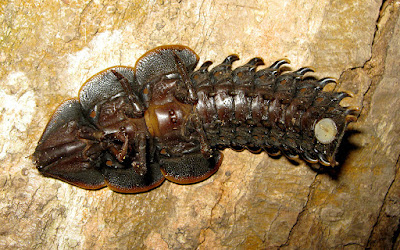 |
| Image: budak |
I guess you just can't keep a good arthropod down.
 |
| Image: Dave.Dunford |
They're found in the rainforests of India and southeast Asia, where they enjoy the musty atmosphere in the leaf litter and near rotting logs.
 |
| Image: Paul Williams |
So, even as adults their thorax is armoured with three massive slabs of exoskeleton called scutes, each one associated with one pair of mighty legs and no wings whatsoever. The abdomen is long and richly endowed with ancient spikes and archaic knobs, each one lovingly highlighted with bright orange to stand out against a black background. It's all a bit Ankylosaurus, except that trilobites were there long before those upstart dinosaurs came along and stole all their ideas.
Video: DarkRaptorMacro
Then there's the head... if you can find it! It's incredibly puny and bears two tiny eyes and a pair of short, knobby antennae. It's even more unreasonably small than the Stegosaur's head and, when required, can disappear entirely by retracting into that thickly armoured thorax. So that's a bit of tortoise thrown in, too. Those Ankylosaurs didn't think of that now, did they? They must be kicking themselves. Or swinging their bone-club tail at their shins.
Trilobite Beetles don't have a club at the end of their tail, nor any kind of weapon. Instead, they have a sort of stopper that they can press against the ground. It's useful because Trilobite Beetles can reach about 8 cm (3 in) long and lack the kind of fleshy prolegs we see on caterpillars.
 |
| Image: Chun Xing Wong Underside |
BUT!
All of this is the female. Males are completely different. Which is to say, they're completely normal.
 |
| Image: Tiia Monto Male and female |
Aside from that, there's a lot yet to be discovered about Trilobite Beetles. No one's quite sure what they even eat!
Video: National Geographic
Among Net-winged Beetles, it's common for the larvae to hang out in rotten logs and leaf litter feeding on worms and snails. It's possible that Trilobite Beetles do the same, although some people think they actually eat fungi and the like. Or maybe that's wrong, too? They might feed on what I think we can reasonably call 'rot-juice,' the nasty liquids that seep out of rotting wood. And I think we reasonably call that stuff 'nasty' because it's full of all manner of tiny protozoans and mites. Of course, for a Trilobite Beetle that would be a delicious, meaty soup. I'd prefer chicken.
Adult Net-winged Beetles typically do most of their eating in their youth when they're busy growing up big and strong. As adults they feed on nectar to get the energy they need to fly about and find mates, or else they eat nothing at all. That could be the case for male Trilobite Beetles since they don't seem to live long.
 |
| Image: Bernard DUPONT |
The female went out in the open and waved her hind-quarters around, possibly emitting pheromones as she did so. Eventually, a male came along, clamped himself to her gonopore (can we reasonably call that 'lady parts?') and copulated for about five hours. I don't know if he managed that on an empty stomach or if he needed a healthy supply of nectar first.
 |
| Image: Chun Xing Wong |
Gosh. They do say that life was nasty, brutish and short in the old days. I guess the Trilobite Beetle felt content to leave it that way.

7 comments:
Well, now I´ve read all about the trilobite beetle...What can I say? Beautiful, weird and wonderful :)
Yup! They tick all the boxes!
That head to body ratio really cracks me up!
What animal has the smallest head or brain compared to its body? Anyone who knows? Mabye the answer is here somewhere, and I just haven´t found it yet.
@Esther: I know! I don't know why they bothered!
@Maria Thulin: I would love to see a smaller head than this. I don't know if such a thing is possible!
well, mother nature likes rehashing idea, huh? We have a beetle with a trilobite design, can pull its head into its thorax like a turtle/tortoise, and has a caterpillar style stopper at the end of its abdomen. Sounds like me and mother nature will get along splendidly with our hybrids. BTW, i wonder what purpose the spikes on the underside of the abdomen serve. Maybe makeshift legs?
Maybe they are makeshift legs, I hadn't really thought of it. Perhaps it gives them some traction when they're climbing around those damp logs
Post a Comment